International Journal of Scientific & Engineering Research, Volume 4, Issue 7, July-2013 1107
ISSN 2229-5518
Experimental and Numerical Comparison of Heat Transfer Performance of Twisted Tube and Plain Tube Heat Exchangers.
Ms.Vandita Thantharate, Dr.D.B.Zodpe
Abstract— In heat exc hangers various active and pass ive tec hniques have b een us ed over plain tubes to enh anc e heat tran sfer. Twisted tube is a passive tec hnique. Pres ently twisted tubes are limited to s hell and tube typ e long and s traight pass ag e app lic ations. T he main aim of this s tudy is to determine its f easibility f or us e in applic ations like autom obile radiators , air c onditioners or similar typ e of multi pass applic ations . In pres ent study, twis ted tube is c ompared with plain tube in multiple tube pass (4 passes) of 0.3 m length eac h pass f or four flow rates of 1.5 lpm, 1.37 lpm, 0.5 lpm and 0.24 lpm res ulting in Reynolds number of Re 625 to 7000 c overing turbulent and laminar range. The c omparis on is don e anal ytic ally, experimentally and numeric ally. T he results s howed that f or the given mass flow rates and inlet temperature, the perf ormanc e of plain tube is better than twis ted tube in low f low rates.For high Reyn olds number range the perf ormanc e of twis ted tube is better, the reas on is attac hed flow through tubes. Thus this s tudy c onc ludes that f or multi pass c onfiguration one s hould al- ways sel ect twisted tubes acc ording to the required flow rate.
Index Terms— heat transfer coefficient, multipass heat exchanger, plain tube, Reynolds Number, synergy angle, Twisted tube heat
exchanger, temperature difference.
1 INTRODUCTION
—————————— ——————————
n heat exchangers the primary focus is to maximize heat transfer rate, reduce exchanger size and reduce pumping power. In view of this various active and passive techniques have been used over plain tubes. Twisted tube is a passive technique. Presently twisted tubes are limited to shell and tube type long and straight passage applications. The main aim of this study is to compare the performance of plain tube heat exchanger with twisted tube heat exchanger on various aspects to determine its feasibility for use in applications like automobile radiators, air conditioners or similar type of multi
pass applications.
“Xiang-hui Tan et.al [3]”, stated the effects of geometrical
parameters on the performance of the twisted oval tube. The
result reveals that the heat transfer coefficient and friction fac- tor both increase with the increase of axis ratio a/b, while both decrease with the increase of twist pitch length P. They also stated that the emergence of twist in the twisted oval tube re- sults in secondary flow. It exists in the form of spiral flow when a/b is big, but in the form of up and down when a/b is small. It is this secondary flow that changes the total velocity and temperature distributions of the twisted oval tube when compared with a smooth oval tube with the same sectional geometric parameters. Then the synergy angle between veloci- ty vector and temperature gradient is reduced and the heat transfer process is enhanced.
————————————————
• Author Vandita Thantharate is currently pursuing masters of Technology in Thermal power engineering in VNIT, Nagpur, (M.H.), INDIA, PH-
+918275743512. E-mail: vandita.tha@gmail.com
• Author Dr.D.B.Zodpe, Associate Professor, Mechanical Department,
VNIT, Nagpur,(M.H.), INDIA.PH-0+919822712751, E-mail:
dbzodpe@rediffmail.com
“Guo et.al. [1] “, stated the importance of synergy angle, which is the angle between velocity and temperature profile. They stated that better the synergy of velocity and tempera- ture gradient/heat flow fields, higher will be the convective heat transfer rates under the same other conditions. Local val- ues of the three scalar fields should all be simultaneously large, i.e., larger values of cosβ should correspond to larger values of the velocity and the temperature gradient. A larger tube aspect ratio and a smaller twist pitch will result in a high- er synergy level and thereby lead to the improvement of heat transfer, which can well explain the effects of tube structural parameters on the heat transfer performance of the Twisted elliptical tubes (TETs).
“Sheng Yang et.al [4]”, discovered that the experimental
Nusselt numbers/friction factors can be expressed with one
unified equation for entire Reynolds number range, which confirms the early flow transition from laminar to turbulent in Twisted Elliptical Tubes. Heat transfer enhancement mecha- nism of TETs was discussed from the viewpoint of field syner- gy. The longitudinal vortex induced by the twisted tube wall improves the synergy between the velocity vector and temper- ature gradient, which in turn results in a better heat transfer performance.
“Luai m. al-hadhrami et al [7]”, studied the fouling charac-
teristics in a twisted tube and stated that, the fouling in twist-
ed tube steadily increases with time for different values of heat input from 1000 min onward for fluid velocity in the range from 1.0 to 2.0 m/s. This behavior of the fouling rate can be attributed to the fact that at higher fluid velocity, flow becomes turbulent, and this in turn flushes the fouling particles. The time-series correlations for the fouling resistance are found to be logarithmic in nature.
IJSER © 2013 http://www.ijser.org
International Journal of Scientific & Engineering Research, Volume 4, Issue 7, July-2013 1108
ISSN 2229-5518
“Xiang-hui Tan et.al [3]”, stated that the heat transfer coeffi- cient of the twisted oval tube heat exchanger is higher and the pressure drop is lower than the rod baffle heat exchanger. They also stated that analyze of the overall performance of the twisted oval tube shows that the twisted oval tube heat ex- changers works more effectively at low tube side flow rate and high shell side flow rate.
“Ozden Agra et. al.[5]”, showed the variation of pressure drop penalty (h/ΔP) with Reynolds numbers for number of enhanced tubes. They stated that Even though enhanced tubes have higher heat transfer coefficient values, their h/Δp values are lower than those of the smooth tube due to their higher pressure drops. It can be clearly seen that the pressure drop penalty for the investigated tubes is significant for the operating conditions at low Reynolds numbers.
From the above we can find that most of the researchers
focused on the heat transfer and pressure drop performance of
the twisted oval tube heat exchanger with traditional shell- tube heat exchanger design. Therefore in present study the performance evaluation of the twisted oval tube is carried out for multi pass type of heat exchangers. Aiming to obtain the performance, the twisted oval tube heat exchanger and plain tube heat exchanger is experimentally studied in the present work and compared with each other.
In present study, the twisted tube made of major and minor diameters of 18.42 mm and 12.00 mm respectively and pitch of
90 mm, as in fig.1, is studied. The tubes are made of copper
and are enclosed in the duct of 0.30 m x 0.30 m. Tube is made in multiple tube pass (4 pass) of each pass 0.30 m length. This arrangement style is similar to the most common configura- tion for radiator and air conditioners. The performance pa- rameters are then studied in the plain tube of 14 mm ID, 16 mm OD and length of 1.2 meter for comparison in the same environment.

Fig. 1 Dimensions of twisted tube for one turn (dimensions are in mm.)
Four flow rates 1.5 lpm, 1.37 lpm, 0.5 lpm and 0.24 lpm are employed resulting in Reynolds number of Re 625 to 7000 covering turbulent and laminar range.
It is reported by "Guo et.al [2]”, that in twisted tubes, heat
transfer increases because of turbulence and secondary flow. In multipass heat exchangers two tube ends are connected together with circular ends. For good heat transfer, the tube aspect ratio should be high and the pitch should be small as
stated by “Xiang-hui Tan et.al [3]”, but it is not possible to connect tubes with such a metallic twisted pipe because at some point the surfaces overlaps and the passage becomes closed. As shown in fig.2.

Fig.2. Twisted tube with twisted connecting ends.
So in present case the ends are connected with plain circular bends without twists, fig.2a. This is the same end connections as used in case of radiators where two pipes are connected with circular bend. This type of non twisted connections caus- es breaking of the swirl flow at tube ends and thus anywhere in the domain the flow is not allowed to be developed. Thus the main aim of present study is to determine the effect of such non twisted ends on the performance of twisted tube multipass heat exchangers.

Fig. 2a.Twisted Tubes connected with Circular plain ends
2 EXPERIMENTAL STUDY OF TWISTED TUBE AND PLAIN TUBE HEAT EXCHANGER
2.1 Experimental Setup
The setup consists of Duct in which tubes are fitted at the cen- tre. Heater is used in Hot water tank to heat water. Cold water tank is used for collecting the cooled water. A fan is used to force the air over the tubes in the direction perpendicular to tubes thus the system is a type of cross flow heat exchanger. Water from the tank is supplied to tube by natural gravitation- al head while the water from the cold water tank is pumped back to hot water tank. The capacity of hot water tank is 27 liters and heater employed has a rating of 2000 Watts. The tube length excluding the circular ends is 1.2 meters. Anemometer is used to measure the velocity of air. Circular ends of the tubes which are open to atmosphere were insulated in order to reduce the heat loss to the surroundings. Thermocouple of T type is used with a digital temperature indicator. One Gate
IJSER © 2013 http://www.ijser.org
International Journal of Scientific & Engineering Research, Volume 4, Issue 7, July-2013 1109
ISSN 2229-5518
valve at the entrance of the tubes and one Globe valve is used at the exit of tubes.
2.2 Experimental Procedure
Water is heated to a temperature of 353 K in the heater and supplied to the tubes by natural head. In the tubes water gets cooled by air forced outside the tubes using fan. Cooled water is collected on the exit tank and pumped back to the heater. The flow rate and the inlet temperature are changed and the process is repeated for next reading. In experiment two valves are used. One Gate valve is employed before the tubes and the other globe valve is employed after the tubes. Initially only first gate valve is opened but the Globe valve is closed. This
are used with twisted tubes to connect them, fig.2a. This is the same end connections as in case of radiators where two pipes are connected with circular bend. The length of tubes in each pass is 300 mm, though to get fully developed flow in twisted tubes it is essential that the twisted tubes should be sufficient- ly long and should be connected with twisted ends. As a con- sequence the flow does not get sufficient length to get devel- oped. Further as the ends are not twisted the partially devel- oped flow get disturbed here and the result is that the desired flow is not developed. Hence the feature that is to be studied is the effect of connecting ends on the performance of twisted multi pass heat exchangers.
It is seen here that as velocity and temperature profiles are not developed, a proper relationship between them cannot be es- tablished. It is clear from the experiments as well that because there is continuous breaking of the velocity boundary layer the flow is not developed in the tubes, and result is poor for twist- ed tube.
2.4 Data Reduction
The fouling resistance of the heat exchanger is assumed to be zero. First the analytical calculation is done and then it is compared with the experimental readings and calculations. Heat transfer from hot and cold fluids as given by:

Q = mh .Cph .(Thi -Th o ) = mc .Cpc .(Tco - Tci )
(1)
Fig 3. Experimental setup with Twisted Tube inserted in the Duct.
ensures that the tubes are completely filled with water. Globe valve is operated to control the flow rate. For each test run with a constant Duct and tube side flow rate, the system is assumed to be in steady state on the condition that all temper- ature fluctuations do not exceed ± 0.5 degree. First the smooth round plain tube is tested with the different flow rates for the
For calculating the Number of transfer units:


U can be determined by the following formula:
(2)
(3)
temperature of 363 K, 353K C, 343 K. Then the procedure is
repeated replacing the plain tube with twisted tube. Air side
flow rate is fixed at 0.5 kg/s and water side flow rate is varied
In “(3)”, hi and ho can be calculated by employing the relation
for Nusselt number as follows:
0.8 0.3
from 1.5 lpm to 0.24 lpm.
2.3 The Mechanism for Heat Transfer
Nui = 0.023. Re Pr
Nui ⋅ k
(4)
According to “Guo et.al.[1]”, field synergy principle can be applied only to completely developed flow with proper veloci-
ty and temperature profile. Further for good heat transfer the

hi =
di
0.25
(5)
ratio of major to minor diameter should be large and the twist pitch should be small as stated by “Xiang-hui Tan et.al [2]”. To
Nuo
= 0.26. Re0.6 Pr0.37

Prw
(6)
use the twisted tube efficiently with multipass heat exchang-
ers, the above stated geometrical conditions should be fol-
lowed. But practically it is difficult to be achieved because of
h0 =
N ⋅ K
0

d0
the manufacturing infeasibility. As while making highly twist- ed metallic connecting ends, the surface of tube may get over- lapped and chock the flow, fig.2.Thus normal circular bends
Effectiveness for cross flow, one fluid mixed other unmixed,
can be calculated using the following relation:
IJSER © 2013 http://www.ijser.org
International Journal of Scientific & Engineering Research, Volume 4, Issue 7, July-2013 1110
ISSN 2229-5518


In this way outlet temperature of water can be found. Experimental values are found as:
(9)
(8)
3.1 Mathematical model of the simulation
Present study has numerically investigated the heat transfer characteristics of plain and twisted tube by using CFD FLU- ENT software. FLUENT uses the control volume technique to convert the governing equations to algebraic equations so that they can be solved numerically. The control volume technique works by integrating the governing equations for each control volume, and then generates discretization of the equations, which conserves each quantity based on the control volume.
m.Cp.(Th i -Th o ) = U.A.F.ΔTLMTD (10)
Friction factor for the plain tube is determined by:
64
In the simulation of fluid flow, the Realizable k-ɛ model is
chosen. As suggested in the studies done by ”Li-ding Zeng [3]”. Simple algorithm is employed to solve the flow and pres- sure equations. Standard method is used in the pressure term.
Laminar range:

f = (11)
Re
Second order upwind algorithm is employed in the discretion
of the rest equations. Standard wall function method is em-
Turbulent range:
0 ⋅ 316

0⋅25
e
(12)
ployed in simulating the boundary layer motion of the fluid. The whole simulation work is done with fluent 14.5 on a Sony
Friction Factor for twisted tube is given in the form of unified
equation by”Sheng Yang et.al.[4]”, as :
Laptop.
1⋅686
f = 1⋅ 529 ⋅ R-0.350 Ai s
-0⋅366
(13)
3.2 Boundary conditions:


e B d
The boundary conditions are described as follows:
i e
The pressure drop for both the tubes was calculated by the equation given by “Ozden Agra et. al.[ 5]”
L ρU 2
(1) Water inlet: mass flow inlet condition is assigned to
the tube inlet for water. Mass flow rate for 1.5 lpm is
0.025 kg/s and the inlet temperature is set to 353 K.


∆P = f
(14)
Tube side flow rate is varied from 0.025 kg/s to
d 2
For calculating the Reynolds Number:
8.33×10-6 kg/s.
(2) Air inlet: velocity inlet condition is assigned to air in-
Re

= ρ vD
µ
let with a value of velocity as 5 m/s, and temperature of 313 K.
(3) Outlet: Pressure outlet condition is assigned to duct
(H1y5)draulic diameter:
and tube exit sides. Zero gauge pressure is set to these

d = 4 AC
e p
(16)
boundaries in order to get the relative pressure drop between inlet and outlet.
(4) Duct and tube: These are assigned as wall boundaries
3 NUMERICAL SIMULATION APPROACH
In order to get the heat transfer performance of the twisted and plain tube, velocity and temperature distributions are comparatively analyzed with fluent 14.5 in CFD software. CFD stands for computational fluid dynamics. The geomet- rical parameters are same as those in the experimental study. The model is created in CATIA V5, Generative Shape Design and it is imported to ICEM for meshing. For surface meshing All Tri elements were used and for volume meshing Tetra Mixed mesh is used. Total numbers of elements are 532528 and 540532 for plain tube with duct and twisted tube with duct respectively. The mesh count is kept approximately equal so that the analysis can be done on an equivalent basis.
with convective and coupled conditions.
(5) The turbulence intensity and hydraulic diameters are
set as: In tubes: I=2 %, DH =0.014 m, in duct: I=2 %, DH =0.3 m.
4 RESULTS AND DISCUSSION
Experimental, analytical and numerical studies are done to determine the behavior of twisted tube with circular end con- nections and compared with the plain circular tube with circu- lar end connections in order to analyze twisted tube‘s applica- bility in multipass applications like Radiators, air conditioners and similar kind of multipass application.
IJSER © 2013 http://www.ijser.org
International Journal of Scientific & Engineering Research, Volume 4, Issue 7, July-2013 1111

ISSN 2229-5518
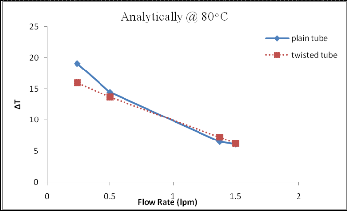
Fig 4. Comparison of the overall heat transfer coefficient for twisted tube.
Experimentally the flow rate used is in low Reynolds number range of Re 600-7000. Analytical calculations are used to verify the experimental setup. Using the experimental and analytical values, CFD model is validated. Comparisons of the perfor- mance of both the tubes are shown:
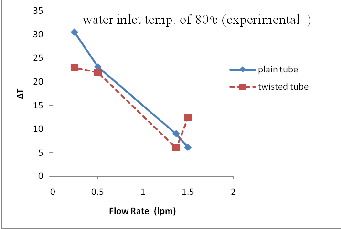
The comparison in fig.4, is done by plotting the trend line
Fig.5. Experimental comparison of temperature difference (K) for plain and twisted tube at the inlet water temperature of 353 K.
showing the pattern for experimental variations. It can be shown that there is an average of 30% deviations between the values of experimental and analytical results due to inefficien- cies in manual operating procedure. The variation trend is showing increasing overall heat transfer coefficient with in- crease of Reynolds Number as expected.
From fig.5, we can see that at low flow rates the performance
of plain tube is better but at high flow rates performance of twisted tube is better. The reason is that at low flow rates the turbulence is small and the velocity profile is not properly de- veloped in twisted tube. But in plain tube though the turbu- lence is less but the velocity and thermal boundary layer are fully developed, so the synergy angle is good. But in case of
Fig. 6, Analytical comparison of temperature difference (K) for plain and twisted tube at the inlet water temperature of 353 K.
undeveloped velocity profile in the twisted tube the synergy is not maintained and thus heat transfer is low in low flow rates. At high flow Rates turbulence in twisted tube is greater than the plain tube. Further as the flow rate is high the flow is attached with the walls and thus there is a good velocity profile. This results in good synergy angle and the heat transfer is better compared to plain tube.
In fig.5 and fig.6 the experimental and analytical comparison is shown. It can be noted that the pattern for the variations of temperature difference is same in both the cases. Similar is the trend for 363 K and 343 K. The comparison of friction factor calculated from”11” for laminar and “12” for turbulent range for plain tube and “13” for twisted tube is given in the fig .7.

Fig.7. Analytical comparison of friction factor for plain and twisted tube.
Pressure drop performance is also determined analytically by “14”. It can be concluded from fig .8, that the pressure drop is more for twisted tube as expected. But the difference is very low in the low flow rates as the velocity is very low to cause any major difference in the pressure as the fluid moves in lam- inas but at high flow rates the difference is more as the turbu- lence velocity is very high causing appreciable drop in pres- sure.
IJSER © 2013 http://www.ijser.org
International Journal of Scientific & Engineering Research, Volume 4, Issue 7, July-2013 1112
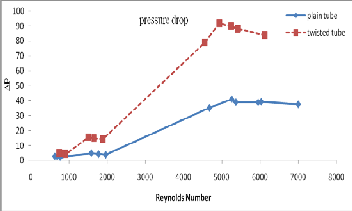
ISSN 2229-5518
Fig.8. Analytical pressure drop comparison for plain and twisted tube.
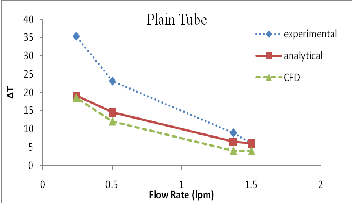
Heat transfer performance is determined by CFD also. The comparison is done in fig .9, for plain tube and in fig.10, for twisted tube. It can be noted here that the variation is same analytically, experimentally as well as by CFD. It can also be noted here that CFD results are in good agreement with the analytical results.
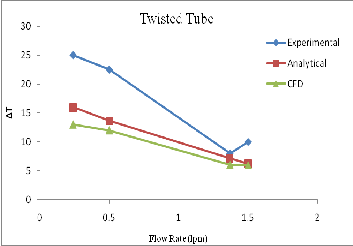
Fig.9. Comparison for temperature difference (K) at inlet water tempera- ture of 353 K for plain tube, including CFD Results.
Fig.10. Comparison for temperature difference (K) at inlet water tempera- ture of 353 K for Twisted tube, including CFD Results.
Analytical comparison of the Nusselt number for plain and twisted tube in fig.11 shows, that the Nusselt number is high for the plain tube in low Reynolds number range but at high
Reynolds number range twisted tubes begins to show high
Nusselt Number.
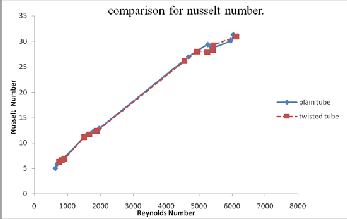
Fig. 11. Analytical comparison of Nusselt Number for plain and twisted tube.
5 CONCLUSIONS
In the present work, an experimental study of the heat transfer performance of plain tube and twisted tube for multipass heat exchanger has been carried out and compared with each other. Analytical study has also been done to get the experimental and Numerical values verified. For determination of pressure drop analytical calculations are done. Tube and Duct type of cross flow heat exchanger was employed. Reynolds number range is from 600 to 7000 covering laminar and turbulent range. The important findings are listed below:
(1) Dimensions of plain tube is 14 mm ID,16mm OD for
twisted tube it is 9.21 mm major radius and 6 mm minor radius with length of 1.2 meter for both the tubes. Ellipti- city of twisted tube is 0.76. Air side flow rate is fixed at
0.52 kg /sec and water side flow rate is varied from 0.24 lpm to 1.5 lpm.
(2) For good heat transfer performance of twisted tube aspect ratio, defined as the ratio of major to minor diameter of the twisted tube, should be high and pitch should be low. It will be very difficult to follow this condition to make connecting ends in case of multipass heat exchanger, as the surface of highly twisted metallic pipe will be over- lapped at some point and the path will be choked. There- fore the end connections should be plain circular.
(3) With the circular connecting ends in twisted tubes the flow tries to generate swirl in the twisted part. But as the length is very short, fully developed velocity profile is not produced. Further with the plain circular ends the little developed velocity profile gets again disturbed. The result is that anywhere in the domain the velocity and tempera- ture profiles are not allowed to be fully developed.
(4) With undeveloped velocity and temperature profiles syn- ergy between them is not established. Thus the heat trans- fer is not good. In present study, performance of twisted tube is better at high Reynolds number range. The reason
IJSER © 2013 http://www.ijser.org
International Journal of Scientific & Engineering Research, Volume 4, Issue 7, July-2013 1113
ISSN 2229-5518
is that the flow under such condition is highly turbulent and the swirls are developed, although partially, results in good heat transfer.
(5) In low flow rate plain tube is better than twisted tube by
8.71 % whereas in high flow rates twisted tube is better by
45 %. Thus the study shows that in multipass heat ex-
changer plain tube should be used for low flow rate appli-
cations. But for the applications like Radiators and Air conditioners where the flow rate is high twisted tubes
should be used. As in these applications reducing the heat exchanger size is very important. In case of automobile radiators, saved space can be used to increase the passen- ger compartment. And in refrigerating units the cost and floor space can be saved from compact construction of the heat exchangers.
(6) For the applications involving high flow rate and low
temperature range, twisted tubes can be connected with
the rubber pipes as these are easy to twist. But while using such twisted rubber pipes for the end connections it should be ensured that the continuity of the flow is main- tained. The flow should not get disturbed through the connections and the velocity profile should be developed.
6 APPENDICES
The Nomenclature of the symbols used is given in the table below:
Table.1, Nomenclature .
7 ACKNOWLEDGEMENT
Special thanks to Dr. S.B. Thombre, Associate Professor, Me- chanical Engineering Department, for providing technical support for completing the study.
8 REFERENCES
[1] Z.Y. Guo a, W.Q. Tao b, R.K. Shah,” The field synergy (coordination) principle and its applications in enhancing single phase convective heat transfer”, 26 January 2005, International Journal of Heat and Mass Trans- fer 48 (2005) 1797–1807
[2] Xiang-hui Tan, Dong-sheng Zhu, Guo-yan Zhou, Li-ding Zeng, “Heat transfer and pressure drop performance of twisted oval tube heat ex- changer”, 29 June 2012, Applied Thermal Engineering 50 (2013) 374e383
[3] Xiang-hui Tan, Dong-sheng Zhu, Guo-yan Zhou, Li-ding Zeng,” Ex- perimental and numerical study of convective heat transfer and fluid flow in twisted oval tubes”, 14 May 2012, International Journal of Heat and Mass Transfer 55 (2012) 4701–4710
[4] Sheng Yang, Li Zhang, Hong Xu,” Experimental study on convective heat transfer and flow resistance characteristics of water flow in twisted elliptical tubes”, 30 May 2011 ,Applied Thermal Engineering 31 (2011)
2981e2991
[5] Özden Ağra, Hakan Demir , Ş. Özgür Atayılmaz, Fatih Kantaş, Ahmet
Selim Dalkılıç,” Numerical investigation of heat transfer and pressure
drop in enhanced tubes”, 9 August 2011, International Communications in
Heat and Mass Transfer 38 (2011) 1384–1391
[6] Gh.S. Jahanmir, F. Farhadi,“Twisted bundle heat exchangers perfor-
mance evaluation by CFD (CJ12/5054)”, 14 September 2012, International
Communications in Heat and Mass Transfer 39 (2012) 1654–1660
[7] Luai M. Al-Hadhrami, Aftab Ahmad & Abdullah Al-Qahtani,” Exper- imental Study of Fouling Resistance in Twisted Tube Heat Exchanger”, 11
Apr 2012, Heat Transfer Engineering, 33(12):1024–1032, 2012
[8] Li Zhang, Sheng Yang, Hong Xu,” Experimental study on condensa- tion heat transfer characteristics of steam on horizontal twisted elliptical tubes”, 23 December 2011, Applied Energy 97 (2012) 881–887
[9] Smith Eiamsa-ard a, Pongjet Promvonge,” Performance assessment in a heat exchanger tube with alternate clockwise and counter-clockwise twisted-tape inserts”, 8 January 2010, International Journal of Heat and Mass Transfer 53 (2010) 1364–1372
[10] Blazo Ljubicic”, testing of twisted Tube Exchangers in Transition Flow Regime”, Brown fin tube company ,12602 FM 529,Houston,TX 77041 [11] R. Donald Morgan,” TWISTED TUBE HEAT EXCHANGER TECH- NOLOGY”, Brown Fintube Company.
[12]Dr. D.S. Kumar, “Heat and Mass Transfer”, Katson books, 7thEdition:
2007-2008.
IJSER © 2013 http://www.ijser.org












